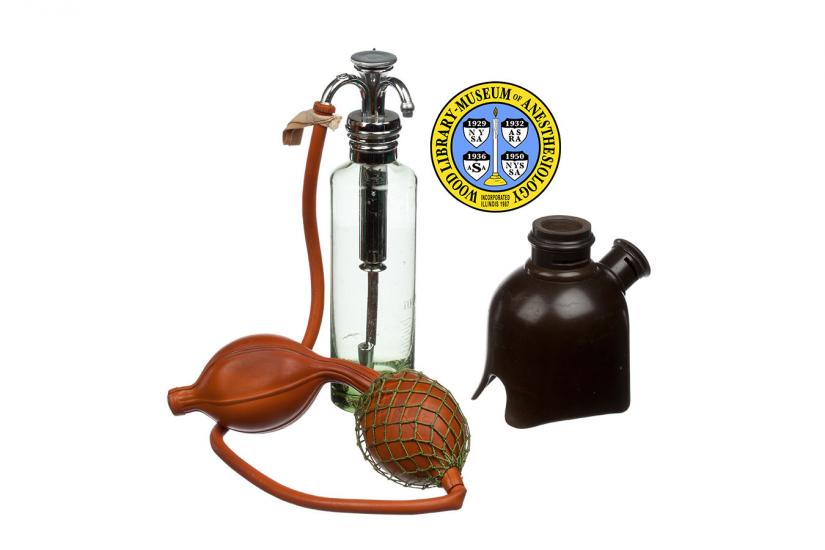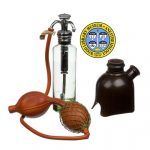Junker Inhaler
Dr. Ferdinand E. Junker (1828-1901) was born and educated in Vienna, Austria. His career took him to England, Germany, and Japan. In 1867, he introduced his inhaler for bichloride of methylene, which is a mixture of chloroform and methyl alcohol. It was the first inhaler to use the "blow-over" principle, pushing air over the liquid anesthetic by means of a hand-pumped rubber bellows. Over the next sixty years more than a dozen modifications of the Junker Inhaler were introduced. These included designs by some of the most noted anesthesiologists of their day, Drs. Frederic W. Hewitt, Dudley Buxton, and C. Carter Braine. In 1878, the London surgical instrument maker, Krohne & Sessemann, offered this modification. A small feather poised on top of the vulcanite mask acted as an indicator of the patient's breathing. The Junker bottle was later incorporated in the Shipway Apparatus.
Catalog Record: Junker Inhaler
Access Key: akoa
Accession No.: 199801-21-2
Title: [A modification of the Junker inhaler] / [designed by Ferdinand Ethelbert
Junker ; modified by Morris Rigby].
Author: Junker von Langegg, Ferdinand Adalbert, 1828-1901.
Author: Rigby, Morris.
Title variation: Alt Title
Title: Junker’s inhaler.
Title variation: Alt Title
Title: Rigby’s safety bottle with Junker’s inhaler.
Title variation: Alt Title
Title: A safe Junker’s inhaler: as made for Morris Rigby.
Publisher: London : Down Bros., [1917-1940].
Physical Descript: 1 anesthesia kit : glass, metals, rubber, textile, wood, leather : 22 x 22.5
x 13.5 cm.
Subject: Anesthesia, Inhalation – instrumentation.
Subject: Nebulizers and Vaporizers – instrumentation.
Subject: Inhalers, Anesthesia – Great Britain.
Subject: Methylene Chloride.
Subject: Chloroform.
Subject: Junker von Langegg, Ferdinand Adalbert, 1828-1901.
Note Type: General
Notes: The early year in the date range for the possible year of manufacture is
based on the year that Dr. Morris Rigby introduced his modification. The late
year is a rough and generous estimate based on the decrease in popularity of
the inhaler during the 1930s. The date range could change if new
documentation that indicates that the dates should be corrected.
Note Type: Citation
Notes: Buxton DW. A modification of Dr. Junker’s Inhaler. Lancet.
1884;124(3188):595-596.
Note Type: Citation
Notes: Hewitt F. A modification in Junker’s chloroform inhaler. Lancet.
1892;139(3583):966-967.
Note Type: Citation
Notes: Junker FE. Description of a new apparatus for administering narcotic vapours.
Med Times Gaz. November 30, 1867;2:590.
Note Type: Citation
Notes: Mulnier C, Zuck D. Junker. Hist Anaesth Soc Proc. 2002;30:79-81.
Note Type: Citation
Notes: Rigby M. A modification of the Junker inhaler. Lancet. 1917;190(4919):862-863
Note Type: Citation
Notes: Down Brothers. A safe Junker’s inhaler: as made for Morris Rigby
[advertisement]. J Laryngology Rhinology Otology. 1918;33(12):front matter.
https://journals.cambridge.
org/action/displayAbstract?fromPage=online&aid=1274800. Accessed November 9,
2013.
Note Type: Citation
Notes: Silk JFW. The administration of anaesthetics in home military hospitals. Proc
R Soc Med. 1918;11(Sect Anaesth):1–13.
Note Type: Citation
Notes: Silk JFW. The administration of anesthetic in home military hospitals. Am J
Surg. January, 1920;34(12)(anesth analg suppl):2-6.
Note Type: Physical Description
Notes: One kit for inhalation anesthesia in a domed, black leathercovered case; The
case contains a light green glass bottle, with a threaded metal neck; The
bottle measures approximately 16.5 cm in height and 5 cm in diameter; On one
side of the bottle are graduation marks in white; They are numbered at 2, 4,
6, 8, 10, 12, 14, 16, and labeled, “DRMS”; The bottle is topped with a lid
that can screw on the bottle and creates a seal; Extending from the lid is a
curved metal tube that measures approximately 19 cm in height; A filling port
with a metal stopper, and two curved metal ports for rubber tubing extend
from the top of the lid; One of the curved ports is marked with the letter
“B”; A hook for hanging the bottle is also attached to the top of the lid;
Also in the box is a double bulb pumping system with connected rubber tubing,
a long rubber tube attached to the metal connector for the mask, and a
oronasal mask; The mask measures approximately 9 x 8 x 11 cm; The lid to the
bottle and one of the bulbs is marked with “DOWN BROS. [new line] LONDON”;
The metal connector for the face mask is marked with “DOWN BROS”; The inside
lid of the box is marked with “DOWN BROS LTD. [new line] ST. THOMAS’S STREET,
[NEW LINE] LONDON, S.E.I.”.
Note Type: Reproduction
Notes: Photographed by Mr. Steve Donisch, June 10, 2013.
Note Type: Reproduction
Notes: Austrian physician, Ferdinand Ethelbert Junker von Langgeg (1828-1901?)
introduced his original anesthesia inhaler in 1867. He used it to administer
“chloromethyl” (methylene chloride) and chloroform. It was the first
anesthesia system to employ a ‘bubble-through’ vaporizer. This type of
vaporizer blows air through the liquid anesthetic, and then the ‘vaporized’
air is administered to the patient. Other anesthetic apparatus that employ
the bubble-through method include the Hayes Inhaler, the Boyle Bottle and the
Copper Kettle.
Note Type: Historical
Notes: Junker’s original system included hand bulbs that, when squeezed, drove air
through liquid anesthetic in a sealed bottle. If assembled incorrectly liquid
anesthetic, rather than vaporized air, would be pumped to the mask. This was
a considerable safety issue. A number of physicians produced modifications to
improve the safety and function of Junker’s Inhaler, including Sir Frederick
W. Hewitt (1857 – 1916) and Dr. Dudley W. Buxton (1855-1931). Until the late
1920s the Junker Inhaler, and its various modifications, was a favored device
among anesthesiologists.
In 1917 Dr. Morris Rigby introduced the modification pictured here. It was
manufactured by the instrument maker Down Brothers of London. Notably, in
1918 and 1920 anesthesiologist J. Frederick William Silk (1858-1943) reported
that Rigby’s modification of Junker’s Inhaler was one of six pieces of
equipment supplied by the British War Office for the administration of
anesthesia.
Note Type: Publication
Notes: Dudley Buxton’s modification of Junker inhaler. Museum of Historical Medical
Artifacts website. https://www.mohma.
org/instruments/category/anesthesia/anesthesia_set/. Accessed November 6,
2013.
Note Type: Publication
Notes: Junker’s inhaler. Mushin Museum website. https://www.mushinmuseum.org.
uk/junkerinhaler.html. Accessed November 6, 2013.
Note Type: Publication
Notes: Junker-type inhaler for anaesthesia, London, England, 1867-1880. Science
Museum website. https://www.sciencemuseum.org.uk/broughttolife/objects/display
aspx?id=3971. Accessed November 6, 2013.
Note Type: Exhibition
Notes: Chosen for the WLM website (noted November 4, 2013).


